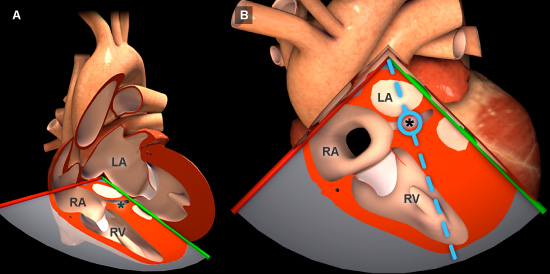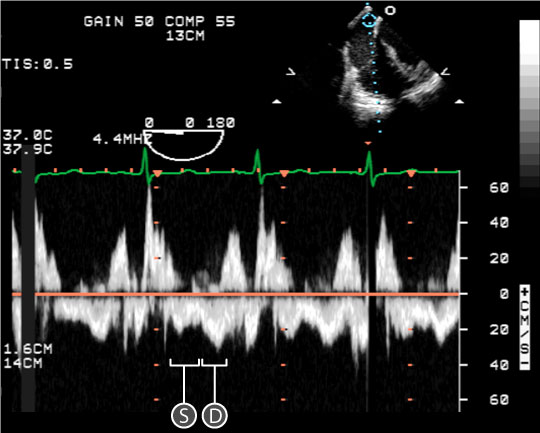Spectral Doppler: Coronary Sinus
Obtaining the spectral Doppler
- From the Mid-esophageal Four Chamber view, advance the probe and retroflex to identify the coronary sinus (CS) in long axis. The final two-dimensional TEE view should appear like the following:
- To assess coronary sinus flow place the pulsed wave (PW) sample 1 cm deep within the centre of the CS (figure 1).
- To aid identification of the CS, apply colour Doppler using a low velocity scale (< 40 cm/sec).

Figure 1: Three-dimensional heart model shown in cross-section to highlight the position of the TEE plane in the deep four chamber coronary sinus view. A) Anterior view of the heart with TEE plane. B) Superior view of the heart. The blue dotted line represents the orientation of the pulsed wave cursor and the blue circle indicates the position of the sample box within the coronary sinus. Key: * = Coronary Sinus, LA = Left atrium, RA = Right atrium, RV = Right ventricle.
Features of cornary sinus spectral Doppler

Figure 2: Spectral doppler data acquired for blood flow through the coronary sinus. In the upper right, a two dimensional TEE image of the deep four chamber coronary sinus view; the blue circle indicates the location of the sample volume where the coronary sinus meets the right atrium. In the lower half of the image, a spectral doppler trace shows the relationship between red blood cell velocity and time. The baseline is orange. Key: D = Diastolic wave, S = Systolic wave.
- A normal coronary sinus spectral Doppler trace has two peaks: the Systolic (S) and Diastolic (D) wave. Both waves are seen below the baseline as the direction of blood flow is away from the transducer (figure 2).
- CS wave velocity is less than 50 cm/sec.
Physiological variation
- Respiratory variation
Pathological variation
- Volume overload
- Tricuspid valve disease
- Arrhythmias
